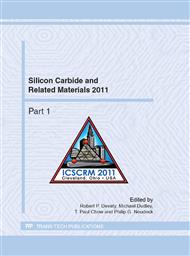p.725
p.729
p.733
p.739
p.743
p.747
p.753
p.757
p.761
The Effects of Phosphorus at the SiO2/4H-SiC Interface
Abstract:
Phosphorous passivation of the SiO2/4H-SiC interface lowers the interface trap density and increases the field effect mobility for n-channel MOSFETs to twice the value of 30-40cm2/V-s obtained using standard NO nitridation. Passivation using P2O5 introduced with an SiP2O7 planar diffusion source (PDS) converts the oxide layer to phosphosilicate glass (PSG) which is a polar material. BTS (bias‐temperature‐stress) measurements with MOS capacitors and FETs show that the benefits of reduced interface trap density and increased mobility are offset by unstable flat band and threshold voltages. This instability can be removed by etching away the PSG oxide and depositing a replacement SiO2 layer. However, trap densities for etched MOS capacitors are "NO-like" (i.e., higher), which would lead one to expect a lower mobility if MOSFETs are fabricated with the PSG / etch / deposited oxide process.
Info:
Periodical:
Pages:
743-746
Citation:
Online since:
May 2012
Price:
Сopyright:
© 2012 Trans Tech Publications Ltd. All Rights Reserved
Share:
Citation:


